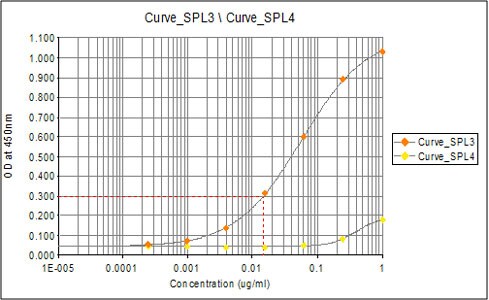Anti-Rad51 (phospho T309) antibody (ab31769)
Key features and details
- Rabbit polyclonal to Rad51 (phospho T309)
- Suitable for: WB, ELISA
- Reacts with: Human
- Isotype: IgG
Overview
-
Product name
Anti-Rad51 (phospho T309) antibody
See all Rad51 primary antibodies -
Description
Rabbit polyclonal to Rad51 (phospho T309) -
Host species
Rabbit -
Tested applications
Suitable for: WB, ELISAmore details -
Species reactivity
Reacts with: Human
Predicted to work with: Mouse, Rat, Rabbit, Chicken, Cow, Xenopus laevis, Zebrafish
-
Immunogen
Synthetic peptide corresponding to Human Rad51 aa 300 to the C-terminus (internal sequence) conjugated to keyhole limpet haemocyanin.
(Peptide available asab33130)
Properties
-
Form
Liquid -
Storage instructions
Shipped at 4°C. Store at +4°C short term (1-2 weeks). Upon delivery aliquot. Store at -20°C or -80°C. Avoid freeze / thaw cycle. -
Storage buffer
pH: 7.40
Preservative: 0.02% Sodium azide
Constituent: PBS
Batches of this product that have a concentration Concentration information loading...
Concentration information loading...Purity
Immunogen affinity purifiedClonality
PolyclonalIsotype
IgGResearch areas
Associated products
-
Compatible Secondaries
-
Isotype control
-
Recombinant Protein
Applications
Our Abpromise guarantee covers the use of ab31769 in the following tested applications.
The application notes include recommended starting dilutions; optimal dilutions/concentrations should be determined by the end user.
Application Abreviews Notes WB Use a concentration of 1 µg/ml. Predicted molecular weight: 36 kDa. ELISA Use at an assay dependent concentration. This antibody gave a positive result in ELISA against the immunizing peptide (ab33130). Optimal dilutions/concentrations should be determined by the end user.
Target
-
Function
Plays an important role in homologous strand exchange, a key step in DNA repair through homologous recombination. Binds to single and double-stranded DNA and exhibits DNA-dependent ATPase activity. Catalyzes the recognition of homology and strand exchange between homologous DNA partners to form a joint molecule between a processed DNA break and the repair template. Binds to single-stranded DNA in an ATP-dependent manner to form nucleoprotein filaments which are essential for the homology search and strand exchange (PubMed:26681308). Part of a PALB2-scaffolded HR complex containing BRCA2 and RAD51C and which is thought to play a role in DNA repair by HR. Plays a role in regulating mitochondrial DNA copy number under conditions of oxidative stress in the presence of RAD51C and XRCC3. -
Tissue specificity
Highly expressed in testis and thymus, followed by small intestine, placenta, colon, pancreas and ovary. Weakly expressed in breast. -
Involvement in disease
Breast cancer
Mirror movements 2
Defects in RAD51 are found in a patient with microcephaly, mental retardation without bone marrow failure and pediatric cancers. -
Sequence similarities
Belongs to the RecA family. RAD51 subfamily.
Contains 1 HhH domain. -
Domain
The nuclear localization may reside in the C-terminus (between 259 and 339 AA). -
Post-translational
modificationsUbiquitinated by the SCF(FBXO18) E3 ubiquitin ligase complex, regulating RAD51 subcellular location and preventing its association with DNA.
Phosphorylated. Phosphorylation of Thr-309 by CHEK1 may enhance association with chromatin at sites of DNA damage and promote DNA repair by homologous recombination. Phosphorylation by ABL1 inhibits function. -
Cellular localization
Nucleus. Cytoplasm. Cytoplasm, perinuclear region. Mitochondrion matrix. Cytoplasm, cytoskeleton, microtubule organizing center, centrosome. Colocalizes with RAD51AP1 and RPA2 to multiple nuclear foci upon induction of DNA damage. DNA damage induces an increase in nuclear levels. Together with FIGNL1, redistributed in discrete nuclear DNA damage-induced foci after ionizing radiation (IR) or camptothecin (CPT) treatment. Accumulated at sites of DNA damage in a SPIDR-dependent manner. - Information by UniProt
-
Database links
- Entrez Gene: 514749 Cow
- Entrez Gene: 5888 Human
- Entrez Gene: 19361 Mouse
- Entrez Gene: 100008661 Rabbit
- Entrez Gene: 499870 Rat
- Omim: 179617 Human
- SwissProt: Q2KJ94 Cow
- SwissProt: Q06609 Human
see all -
Alternative names
- BRCA1/BRCA2 containing complex, subunit 5 antibody
- BRCC 5 antibody
- BRCC5 antibody
see all
Images
-
All lanes : Anti-Rad51 (phospho T309) antibody (ab31769) at 1 µg/ml
Lane 1 : Jurkat (Human T cell lymphoblast-like cell line) Whole Cell Lysate
Lane 2 : Ramos (Human Burkitt's lymphoma cell line) Whole Cell Lysate
Lane 3 : Y79 (Human retinoblastoma cell line) Whole Cell Lysate
Lysates/proteins at 10 µg per lane.
Secondary
All lanes : Goat Anti-Rabbit IgG H&L (HRP) preadsorbed (ab97080) at 1/10000 dilution
Developed using the ECL technique.
Performed under reducing conditions.
Predicted band size: 36 kDa
Observed band size: 39 kDa why is the actual band size different from the predicted?
Additional bands at: 34 kDa, 60 kDa. We are unsure as to the identity of these extra bands.
Exposure time: 20 minutes -
Elisa using ab31769 at varying antibody concentrations. Curve_SPL3 indicates binding to the Rad51 (phospho T309) peptide. Curve_SPL4 indicates
Protocols
To our knowledge, customised protocols are not required for this product. Please try the standard protocols listed below and let us know how you get on.
Datasheets and documents
References (0)
ab31769 has not yet been referenced specifically in any publications.
Customer reviews and Q&As
Images
-
All lanes : Anti-Rad51 (phospho T309) antibody (ab31769) at 1 µg/ml
Lane 1 : Jurkat (Human T cell lymphoblast-like cell line) Whole Cell Lysate
Lane 2 : Ramos (Human Burkitt's lymphoma cell line) Whole Cell Lysate
Lane 3 : Y79 (Human retinoblastoma cell line) Whole Cell Lysate
Lysates/proteins at 10 µg per lane.
Secondary
All lanes : Goat Anti-Rabbit IgG H&L (HRP) preadsorbed (ab97080) at 1/10000 dilution
Developed using the ECL technique.
Performed under reducing conditions.
Predicted band size: 36 kDa
Observed band size: 39 kDa why is the actual band size different from the predicted?
Additional bands at: 34 kDa, 60 kDa. We are unsure as to the identity of these extra bands.
Exposure time: 20 minutes
-
Elisa using ab31769 at varying antibody concentrations. Curve_SPL3 indicates binding to the Rad51 (phospho T309) peptide. Curve_SPL4 indicates
-
-


















